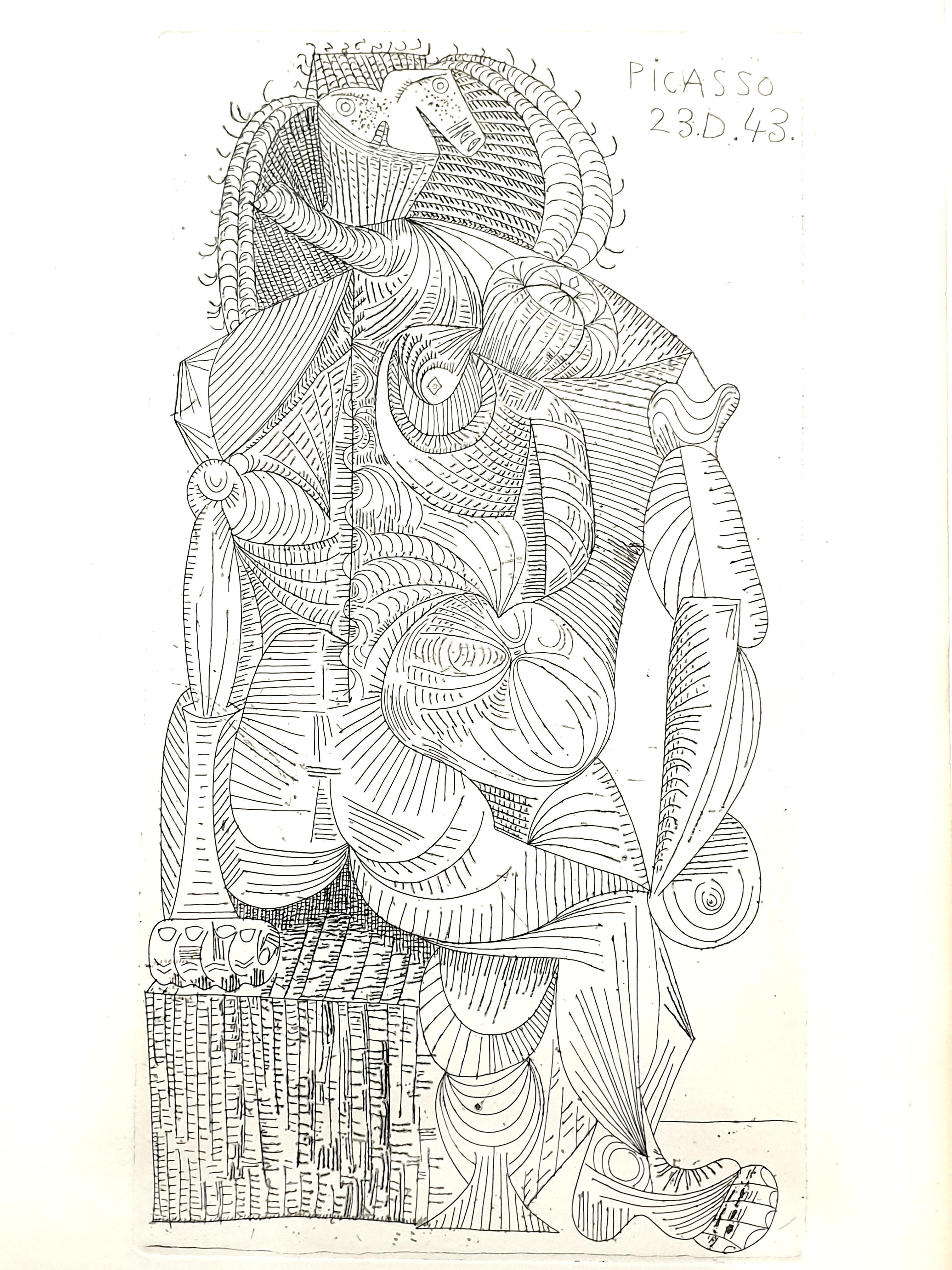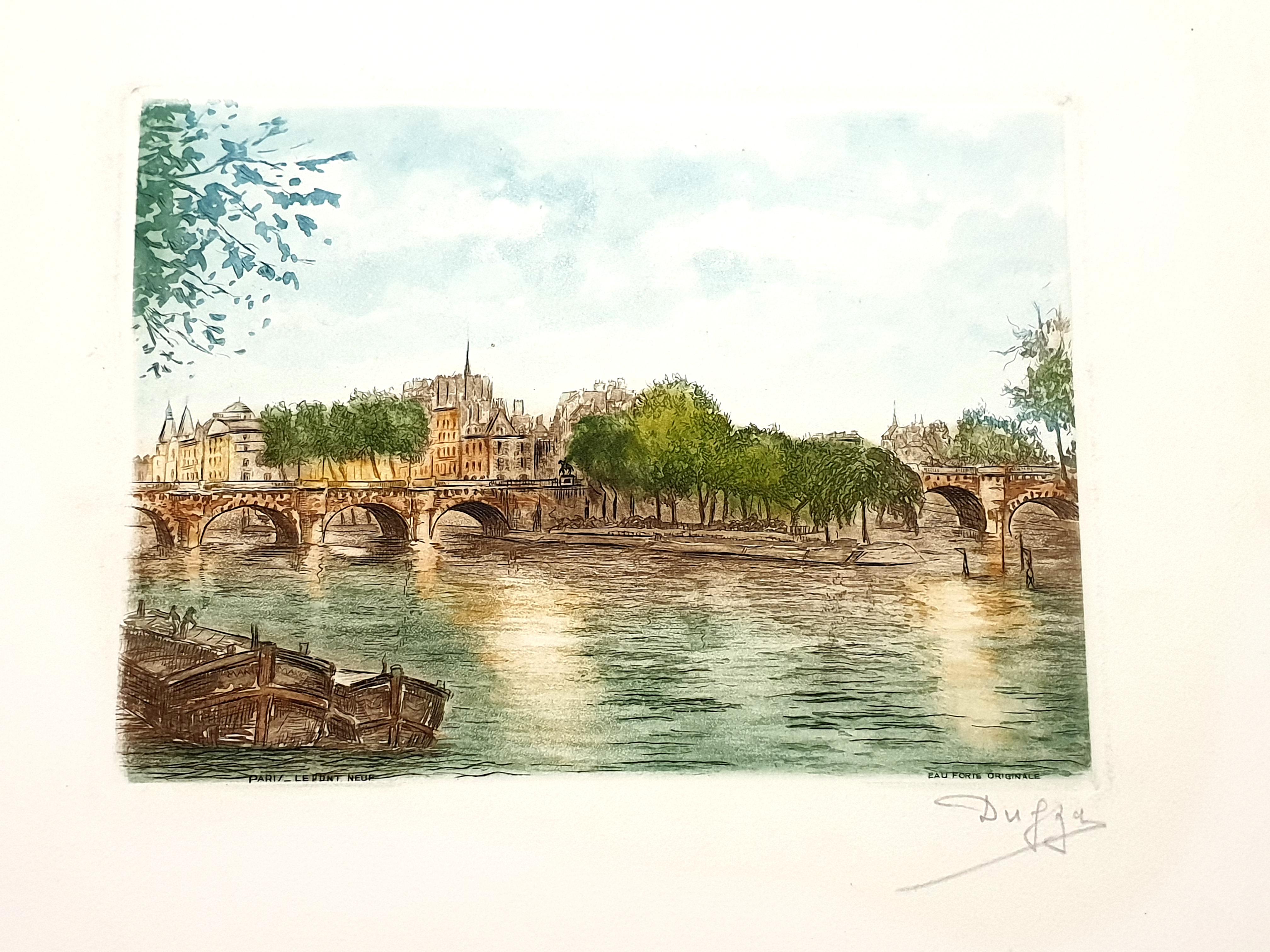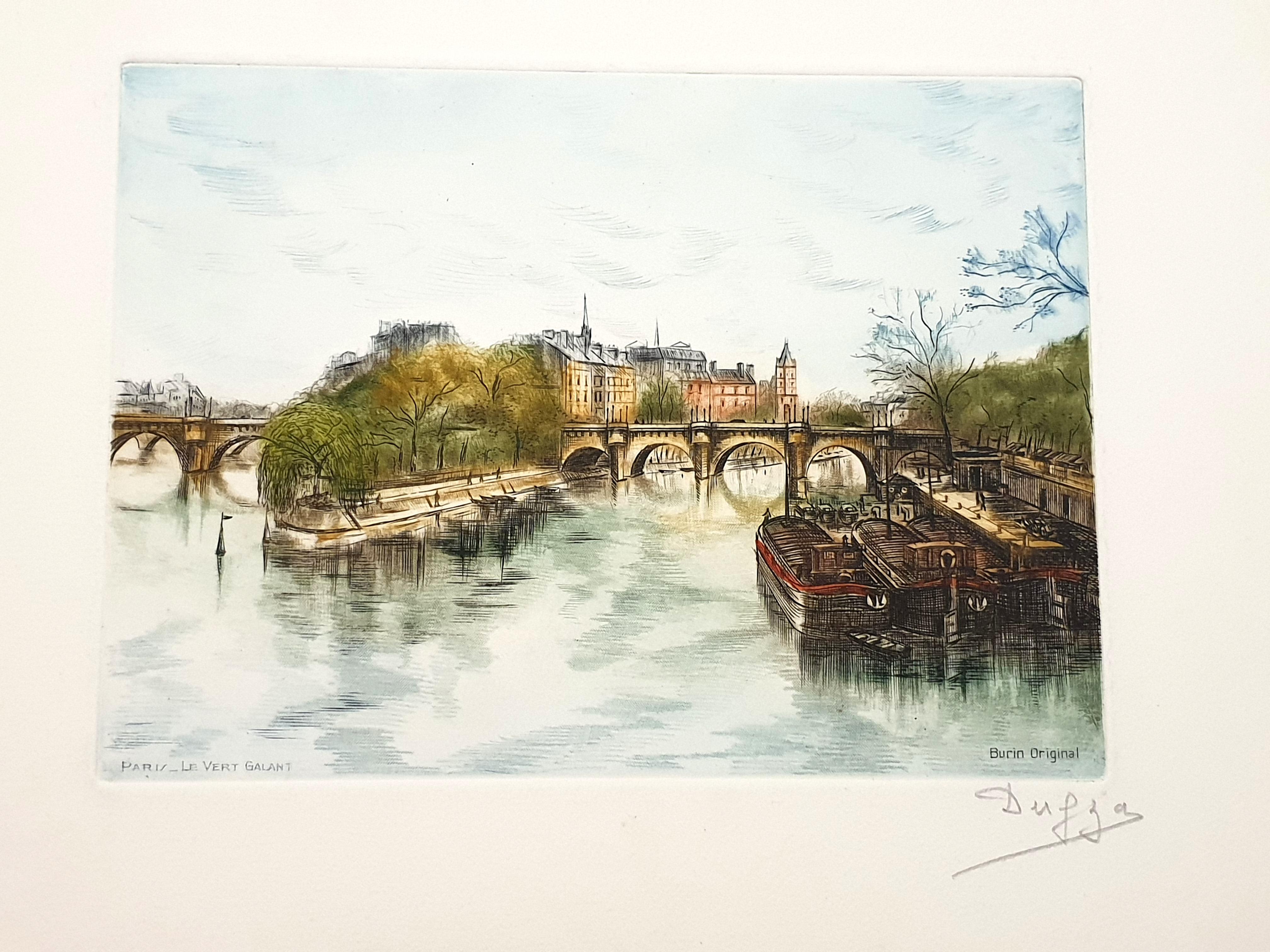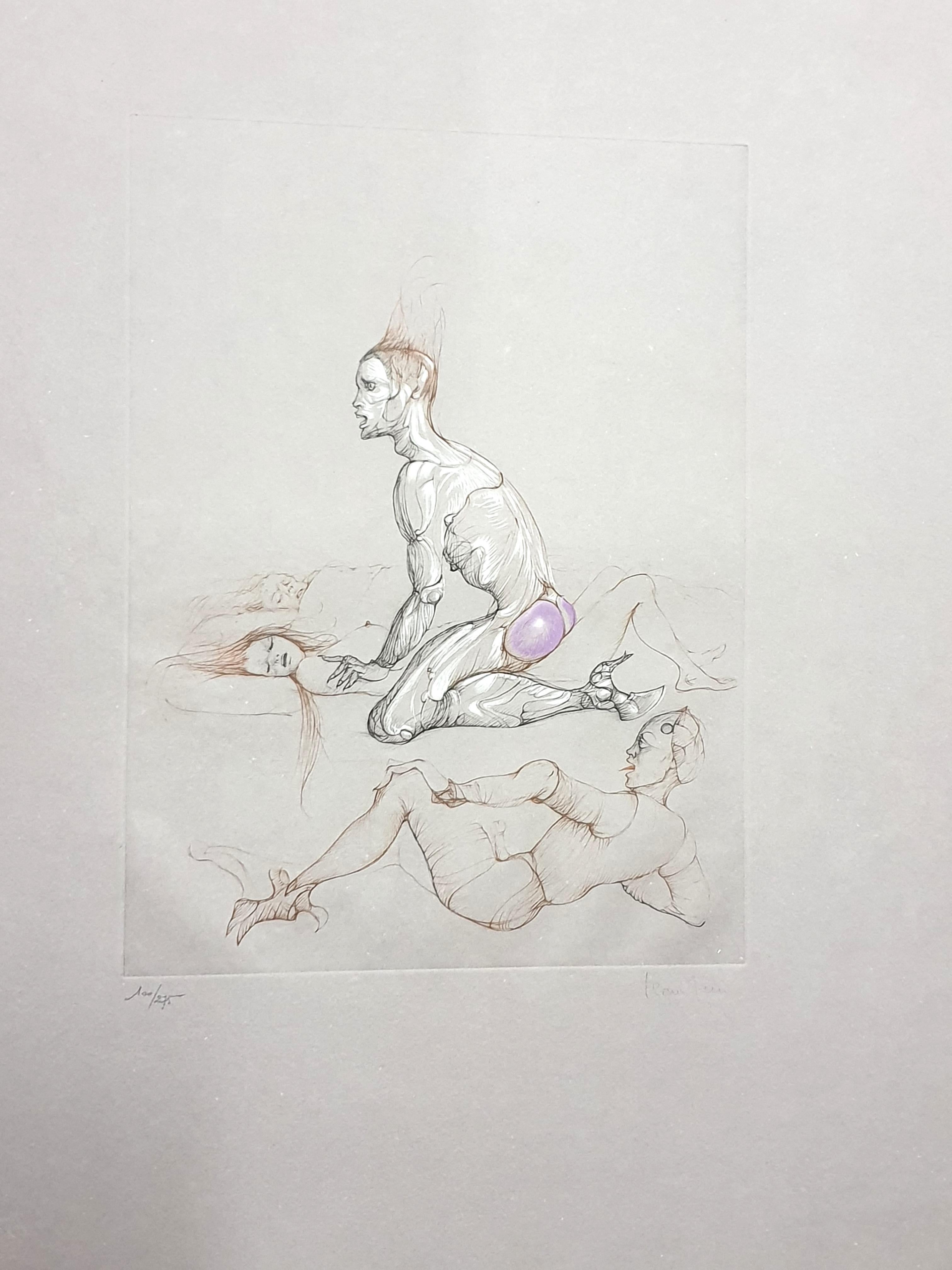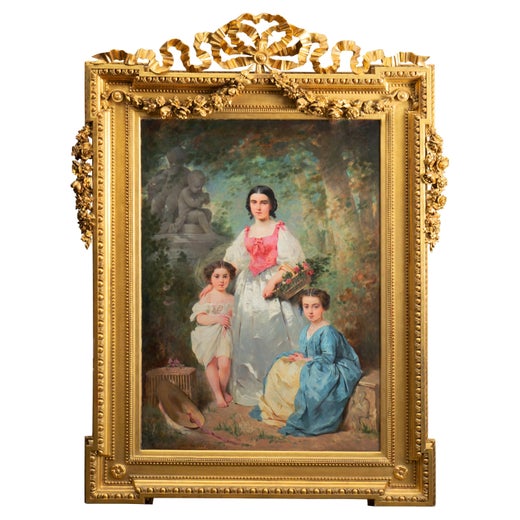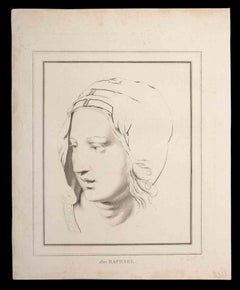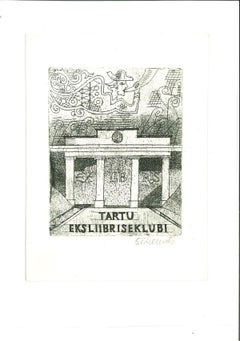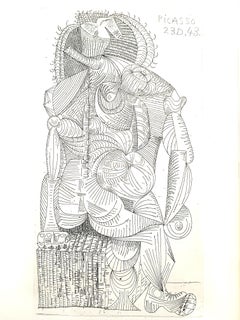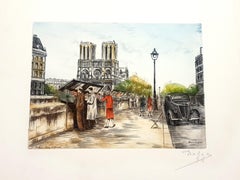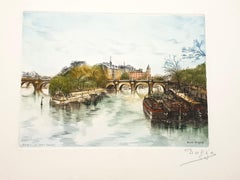Items Similar to Fileuse et son Enfant - Original Etching by Charles Chaplin - 1850
Want more images or videos?
Request additional images or videos from the seller
1 of 5
Charles ChaplinFileuse et son Enfant - Original Etching by Charles Chaplin - 18501850
1850
About the Item
Fileuse et son enfant is an original artwork realized by the French artist Charles Chaplin in 1850.
Original etching on paper on china paper.
Artist's Proof before the address. Signed and dated on plate on the lower central margin.
Good conditions.
Very beautiful and intimate artwork representing a genre scene with a female figure in the center of the composition with a baby on her side. The composition is characterized by dark shades of black and dark shades.
Charles Chaplin (Les Andelys, 1825 - Paris, 1891). He was born in France from an English father; he was one of the pupils of Michel Martin Drolling at the Ecole National de Beaux arts in 1845; his style is inspired from the Rococo painting and from the work of Jean Siméon Chardin and Jean-Etienne Liotard. His work was appreciazted by the empress Eugenia and had several commissions from the Opéra and the Tuileries. Official artist of the Second Empire, he was classified as "Art Pompier". He exhibited his works at the Salon from 1845 to 1868.
- Creator:Charles Chaplin (French)
- Creation Year:1850
- Dimensions:Height: 17.72 in (45 cm)Width: 12.41 in (31.5 cm)Depth: 0.04 in (1 mm)
- Medium:
- Movement & Style:
- Period:
- Framing:Framing Options Available
- Condition:Insurance may be requested by customers as additional service, contact us for more information.
- Gallery Location:Roma, IT
- Reference Number:Seller: M-1010801stDibs: LU65034143702
Charles Chaplin
Charles Joshua Chaplin was born in France to an English father. He was one of the pupils of Michel Martin Drolling at the l'École nationale supérieure des Beaux-Arts in 1845. Chaplin’s style is inspired by the Rococo painting and from the work of Jean-Baptiste-Siméon Chardin and Jean-Etienne Liotard. His work was appreciated by the empress Eugenia and had several commissions from the Opéra and the Tuileries Palace. Official artist of the Second Empire, he was classified as "Art Pompier". Chaplin exhibited his works at the Salon from 1845–68.
About the Seller
4.9
Platinum Seller
Premium sellers with a 4.7+ rating and 24-hour response times
1stDibs seller since 2017
7,496 sales on 1stDibs
Typical response time: 2 hours
- ShippingRetrieving quote...Shipping from: Monaco, Monaco
- Return Policy
Authenticity Guarantee
In the unlikely event there’s an issue with an item’s authenticity, contact us within 1 year for a full refund. DetailsMoney-Back Guarantee
If your item is not as described, is damaged in transit, or does not arrive, contact us within 7 days for a full refund. Details24-Hour Cancellation
You have a 24-hour grace period in which to reconsider your purchase, with no questions asked.Vetted Professional Sellers
Our world-class sellers must adhere to strict standards for service and quality, maintaining the integrity of our listings.Price-Match Guarantee
If you find that a seller listed the same item for a lower price elsewhere, we’ll match it.Trusted Global Delivery
Our best-in-class carrier network provides specialized shipping options worldwide, including custom delivery.More From This Seller
View AllPortrait after Raphael - Original Etching by Thomas Holloway - 1810
By Thomas Holloway
Located in Roma, IT
The portrait after Raphael is an original etching artwork realized by Thomas Holloway for Johann Caspar Lavater's "Essays on Physiognomy, Designed to Promote the Knowledge and the Lo...
Category
1810s Modern Figurative Prints
Materials
Etching
Suite de Vases - Original Etching By Jacques François Saly - 1750s
Located in Roma, IT
Suite de Vases is an original artwork realized by the French artist Jacques François Saly (1717-1776)
Etching print. drawing on the back, 1750 c. Passepartout cm 21x22,5
Good cond...
Category
Mid-18th Century Modern Figurative Prints
Materials
Etching
Ex Libris Eklubi - Original Etching - Mid-20th Century
Located in Roma, IT
Ex Libris Eklubi is an original Contemporary Artwork realized in the 20th Century.
Original Ex Libris.
Original B/W Etching on ivory-colored paper. Hand-signed in pencil on the lo...
Category
Mid-20th Century Modern Figurative Prints
Materials
Etching
L'Elevèment - Etching by Dominique Félix - 1870s
Located in Roma, IT
L'Elevèment is an artwork realized by D. Félix in 1870s.
Etching.
Good conditions.
Realized for the "Société des Aquafortistes. Born on the initiative of the publisher Alfred Ca...
Category
1870s Modern Figurative Prints
Materials
Etching
La chasse du Beau Pécopin - Etching by Charles Amédée De Boret - 1870s
Located in Roma, IT
La chasse du Beau Pécopin is an artwork realized by Charles Amédée De Boret in the 1870s.
Etching.
Good conditions.
Realized for the "Société des Aquafortistes. Born on the initia...
Category
1870s Modern Figurative Prints
Materials
Etching
A Nohant-Vico - Etching by Joseph François Villevieille - 1870s
Located in Roma, IT
A Nohant-Vico is an artwork realized by Joseph François Villevieille in the 1870s.
Etching.
Good conditions.
Realized for the "Société des Aquafortistes. Born on the initiative of...
Category
1870s Modern Figurative Prints
Materials
Etching
You May Also Like
Pablo Picasso - Seated Woman - Original Etching
By Pablo Picasso
Located in Collonge Bellerive, Geneve, CH
Pablo Picasso - Seated Woman - Original Etching
Signed and dated in the plate
1943
Edition: 200
Dimensions: 18.5 x 28 cm
Platemark size : 13.2 x 24.5
Material: LaFuMa paper, watermark on the lower right
Reference: Bloch 362; Baer 689Bb; Cramer 39;
Elliott, Picasso on Paper, National Galleries of Scotland, 2007, illustrated p.84
Pablo Picasso
Picasso is not just a man and his work. Picasso is always a legend, indeed almost a myth. In the public view he has long since been the personification of genius in modern art. Picasso is an idol, one of those rare creatures who act as crucibles in which the diverse and often chaotic phenomena of culture are focussed, who seem to body forth the artistic life of their age in one person. The same thing happens in politics, science, sport. And it happens in art.
Early life
Born in Malaga, Spain, in October of 1881, he was the first child born in the family. His father worked as an artist, and was also a professor at the school of fine arts; he also worked as a curator for the museum in Malaga. Pablo Picasso studied under his father for one year, then went to the Academy of Arts for one year, prior to moving to Paris. In 1901 he went to Paris, which he found as the ideal place to practice new styles, and experiment with a variety of art forms. It was during these initial visits, which he began his work in surrealism and cubism style, which he was the founder of, and created many distinct pieces which were influenced by these art forms.
Updates in style
During his stay in Paris, Pablo Picasso was constantly updating his style; he did work from the blue period, the rose period, African influenced style, to cubism, surrealism, and realism. Not only did he master these styles, he was a pioneer in each of these movements, and influenced the styles to follow throughout the 20th century, from the initial works he created. In addition to the styles he introduced to the art world, he also worked through the many different styles which appeared, while working in Paris. Not only did he continually improve his style, and the works he created, he is well known because of the fact that he had the ability to create in any style which was prominent during the time.
Russian ballet
In 1917, Pablo Picasso joined the Russian Ballet, which toured in Rome; during this time he met Olga Khoklova, who was a ballerina; the couple eventually wed in 1918, upon returning to Paris. The couple eventually separated in 1935; Olga came from nobility, and an upper class lifestyle, while Pablo Picasso led a bohemian lifestyle, which conflicted. Although the couple separated, they remained officially married, until Olga's death, in 1954. In addition to works he created of Olga, many of his later pieces also took a centralized focus on his two other love interests, Marie Theresa Walter and Dora Maar. Pablo Picasso remarried Jacqueline Roque in 1961; the couple remained married until his death 12 years later, in 1973.
Work as a pacifist
Pablo Picasso was a pacifist, and large scale paintings he created, showcased this cry for peace, and change during the time. A 1937 piece he created, after the German bombing of Guernica, was one such influential piece of the time. Not only did this become his most famous piece of art work, but the piece which showed the brutality of war, and death, also made him a prominent political figure of the time. To sell his work, and the message he believed in, art, politics, and eccentricity, were among his main selling points.
Conflicting with social views
Many things Pablo Picasso did during the 1950s, conflicted with the general public. Viciousness towards his children, exaggerated virility towards women, and joining the Communist party, were some of the many scandals which he was involved in during his lifetime. Although most of the things he did were viewed negatively by a minority of the general public, admirers of Pablo Picasso turned a blind eye, and still accepted him as a prominent figure in their society. Following the end of WWII, Pablo Picasso turned back towards his classic style of work, and he created the "Dove of Peace." Even though he became a member of the Communist party, and supported Stalin and his political views and rule, Pablo Picasso could do no wrong. In the eyes of his admirers and supporters, he was still a prominent figure, and one which they would follow, regardless of what wrongs he did. He was not only an influence because of the works he created, but he was also an influential figure in the political realm.
Influence outside of art
Although Pablo Picasso is mainly known for his influence to the art world, he was an extremely prominent figure during his time, and to the 20th century in general. He spread his influences to the art world, but also to many aspects of the cultural realm of life as well. He played several roles in film, where he always portrayed himself; he also followed a bohemian lifestyle, and seemed to take liberties as he chose, even during the later stages of his life. He even died in style, while hosting a dinner party in his home.
Collection of work
Pablo Picasso is recognized as the world's most prolific painter. His career spanned over a 78 year period, in which he created: 13,500 paintings, 100,000 prints and engravings, and 34,000 illustrations which were used in books. He also produced 300 sculptures and ceramic pieces during this expansive career. It is also estimated that over 350 pieces which he created during his career, have been stolen; this is a figure that is far higher than any other artist throughout history.
Sale of his works
Pablo Picasso has also sold more pieces, and his works have brought in higher profit margins, than any other artist of his time. His pieces rank among the most expensive art...
Category
1940s Modern Figurative Prints
Materials
Etching
Dufza - Paris - Saint Michel - Original Handsigned Etching
Located in Collonge Bellerive, Geneve, CH
Dufza - Paris - Saint Michel - Original Handsigned Etching
Circa 1940
Handsigned in pencil
Dimensions: 20 x 25 cm
Unumbered as issued
Category
1940s Modern Landscape Prints
Materials
Etching
Dufza - Paris - Le Pont Neuf - Original Handsigned Etching
Located in Collonge Bellerive, Geneve, CH
Dufza - Paris - Le Pont Neuf - Original Handsigned Etching
Circa 1940
Handsigned in pencil
Dimensions: 20 x 25 cm
Unumbered as issued
Category
1940s Modern Landscape Prints
Materials
Etching
Dufza - Paris - Le Vert Galant - Original Handsigned Etching
Located in Collonge Bellerive, Geneve, CH
Dufza - Paris - Le Vert Galant - Original Handsigned Etching
Circa 1940
Handsigned in pencil
Dimensions: 20 x 25 cm
Category
1940s Modern Landscape Prints
Materials
Etching
Dufza - Paris - Champs Elysées - Original Handsigned Etching
Located in Collonge Bellerive, Geneve, CH
Dufza - Paris - Champs Elysées - Original Handsigned Etching
Circa 1940
Handsigned in pencil
Dimensions: 20 x 25 cm
Unumbered as issued
Category
1940s Modern Landscape Prints
Materials
Etching
Leonor Fini - Untitled - Original Handsigned Etching
By Leonor Fini
Located in Collonge Bellerive, Geneve, CH
Leonor Fini - Untitled - Original Handsigned Etching
Circa 1982
On colored paper
Handsigned and Numbered
Edition: 275
Dimensions: 69 x 52.5 cm
Leonor Fini is considered one of the most important women artists of the mid-twentieth century, along with Leonora Carrington, Frida Kahlo, Meret Oppenheim, Remedios Varo, and Dorothea Tanning – most of whom Fini knew well. Her career, which spanned some six decades, included painting, graphic design, book illustration, product design (the renowned torso-shaped perfume bottle for Schiaparelli’s Shocking), and set and costume design for theatre, ballet, opera, and film. In this compellingly readable, exhaustively researched account, author Peter Webb brings Fini’s provocative art and unconventional personal life, as well as the vibrant avant-garde world in which she revolved, vividly in life.
Born in Buenos Aires in 1907 (August 30 – January 18, 1996, Paris) to Italian and Argentine parents, Leonor grew up in Trieste, Italy, raised by her strong-willed, independent mother, Malvina. She was a virtually self-taught artist, learing anatomy directly from studying cadavers in the local morgue and absorbing composition and technique from the Old Masters through books and visits to museums.
Fini’s fledging attempts at painting in Trieste let her to Milan, where she participated in her first group exhibition in 1929, and then to Paris in 1931.
Her vivacious personality and flamboyant attire instantly garnered her a spotlight in the Parisian art world and she soon developed close relationships with the leading surrealist writers and painters, including Paul Eluard, Salvador Dali, Man Ray, and Max Ernst, who became her lover for a time. The only surrealist she could not abide because of his misogyny was André Breton. Although she repeatedly exhibited with them, she never considered herself a surrealist. The American dealer Julien Levy,
very much impressed by Fini’s painting and smitten by her eccentric charms, invited her to New York in 1936, where she took part in a joint gallery exhibition with Max Ernst and met many American surrealists, including Joseph Cornell and Pavel Tchelitchew. Her work was included in MoMA’s pivotal Fantastic Art, Dada and Surrealism exhibition, along with De Chirico, Dali, Ernst, and Yves Tanguy.
In 1939 in Paris she curated an exhibition of surrealist furniture for her childhood friend Leo Castelli for the opening of his first gallery.
Introductions to her exhibition catalogues were written by De Chirico, Ernst, and Jean Cocteau.
A predominant theme of Fini’s art is the complex relationship between the sexes, primarily the interplay between the dominant female and the passive, androgynous male. In many of her most powerful works, the female takes the form of a sphinx, often with the face of the artist. Fini was also an accomplished portraitist; among her subjects were Stanislao Lepri...
Category
1980s Modern Nude Prints
Materials
Etching
